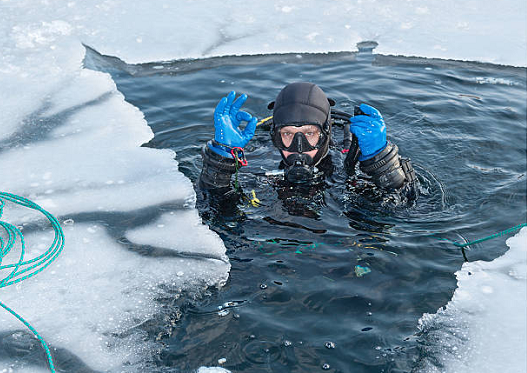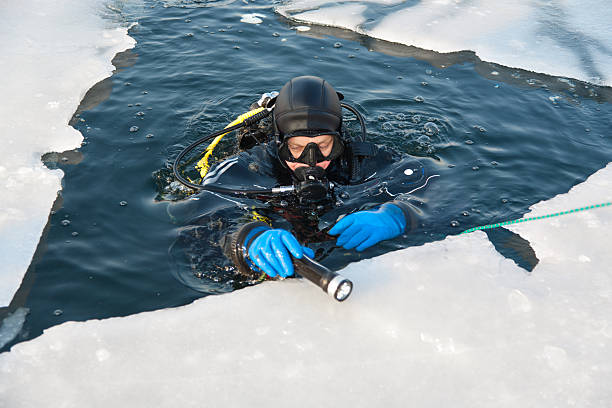Diving beneath the icy surface of the Arctic offers a diving experience unlike any other. Yet, the preparation, gear, and awareness required for such an adventure are extensive. This article dives into the world of ice diving, from its frosty charm and unique challenges to the vital conservation efforts preserving the Arctic’s delicate ecosystem.
What is ice diving?
Ice diving is a specialized form of scuba diving where divers submerge beneath frozen water surfaces, typically in lakes or ponds. The underwater environment beneath the ice is serene, with a crystal-clear view often untouched by wind or other disturbances. This surreal experience isn’t just about the visuals; the silence and serenity are profound.
Diving beneath an ice ceiling means that you usually only have one entry and exit point, making safety a top priority. Special training and equipment, including dry suits to protect against the cold, are essential. Ice diving offers a unique experience but demands respect for its potential risks.
Preparing for the Arctic Plunge
Ice diving is no ordinary scuba diving adventure—it’s an expedition into an untouched world beneath a frozen water surface. With the thrill will come unique challenges that demand a lot of preparation and respect for the risks.
Safety Considerations
The key difference between open water and ice diving is the icy ceiling above, limiting your exit to a single point. This makes safety precautions utterly important. Every diver who ventures under the cold surface must be safely connected to a safety rope (tether line). This vital cable has two functions: guiding divers to the exit hole and offering quick help when needed. Surface support divers/assistants must maintain constant awareness because they are responsible for maintaining these lifelines and safeguarding the safety of divers below.
Furthermore, diving in such difficult conditions should never be done alone. The buddy system is critical, as having a companion underwater ensures frequent checks, providing an extra layer of security. Finally, divers are strongly urged to attend specialist ice diving courses in order to efficiently manage the obstacles of this freezing environment.
Equipment Considerations
When gearing up for an ice dive, the selection of equipment is very important to ensure both safety and a comfortable dive. Foremost are drysuits, distinct from wetsuits, as they are specifically designed to keep you completely dry during the dive, ensuring your body remains untouched by the ice-cold water. Insulated for warmth and equipped with pockets for any necessary added weight, drysuits are indispensable in icy conditions.
Additionally, the chilling waters can cause regular regulators to lose their strength or even freeze. Therefore, specialized ice diving regulators, designed to endure and operate flawlessly in freezing temperatures, are essential, minimizing the threat of an unexpected free flow. For example, the Apeks MTX-R regulator is specifically designed for cold water diving.
Pre-Dive Activities
Before, during and after the dive – you should make sure you don’t get too cold. To ensure this, we recommend you wear thermal layers. Thermal layers, worn beneath dry suits, absorb sweat and keep you toasty. There are special undergarments and thermal layers available for dry suits. A brief pre-dive warm-up is also recommended as it activates metabolism, stabilizing core temperature. Proper nutrition, like warm beverages and a hearty meal, provide additional warmth. Post-dive, it’s vital to quickly change into dry, warm clothes, making sure you don’t get hypothermia.

